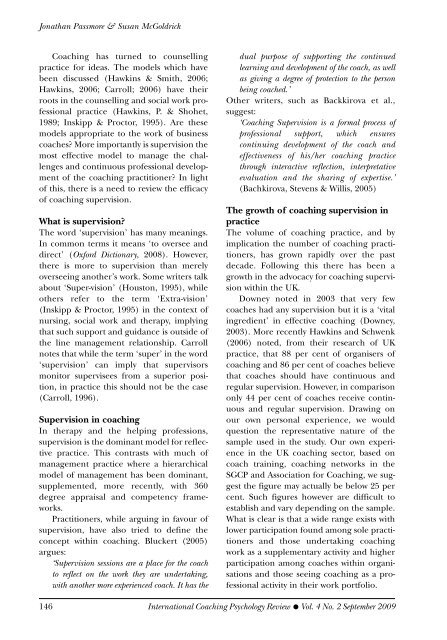International Coaching Psychology Review, 4.2, September 2009
International Coaching Psychology Review, 4.2, September 2009
International Coaching Psychology Review, 4.2, September 2009
Create successful ePaper yourself
Turn your PDF publications into a flip-book with our unique Google optimized e-Paper software.
Jonathan Passmore & Susan McGoldrick<br />
<strong>Coaching</strong> has turned to counselling<br />
practice for ideas. The models which have<br />
been discussed (Hawkins & Smith, 2006;<br />
Hawkins, 2006; Carroll; 2006) have their<br />
roots in the counselling and social work professional<br />
practice (Hawkins, P. & Shohet,<br />
1989; Inskipp & Proctor, 1995). Are these<br />
models appropriate to the work of business<br />
coaches? More importantly is supervision the<br />
most effective model to manage the challenges<br />
and continuous professional development<br />
of the coaching practitioner? In light<br />
of this, there is a need to review the efficacy<br />
of coaching supervision.<br />
What is supervision?<br />
The word ‘supervision’ has many meanings.<br />
In common terms it means ‘to oversee and<br />
direct’ (Oxford Dictionary, 2008). However,<br />
there is more to supervision than merely<br />
overseeing another’s work. Some writers talk<br />
about ‘Super-vision’ (Houston, 1995), while<br />
others refer to the term ‘Extra-vision’<br />
(Inskipp & Proctor, 1995) in the context of<br />
nursing, social work and therapy, implying<br />
that such support and guidance is outside of<br />
the line management relationship. Carroll<br />
notes that while the term ‘super’ in the word<br />
‘supervision’ can imply that supervisors<br />
monitor supervisees from a superior position,<br />
in practice this should not be the case<br />
(Carroll, 1996).<br />
Supervision in coaching<br />
In therapy and the helping professions,<br />
supervision is the dominant model for reflective<br />
practice. This contrasts with much of<br />
management practice where a hierarchical<br />
model of management has been dominant,<br />
supplemented, more recently, with 360<br />
degree appraisal and competency frameworks.<br />
Practitioners, while arguing in favour of<br />
supervision, have also tried to define the<br />
concept within coaching. Bluckert (2005)<br />
argues:<br />
‘Supervision sessions are a place for the coach<br />
to reflect on the work they are undertaking,<br />
with another more experienced coach. It has the<br />
dual purpose of supporting the continued<br />
learning and development of the coach, as well<br />
as giving a degree of protection to the person<br />
being coached.’<br />
Other writers, such as Backkirova et al.,<br />
suggest:<br />
‘<strong>Coaching</strong> Supervision is a formal process of<br />
professional support, which ensures<br />
continuing development of the coach and<br />
effectiveness of his/her coaching practice<br />
through interactive reflection, interpretative<br />
evaluation and the sharing of expertise.’<br />
(Bachkirova, Stevens & Willis, 2005)<br />
The growth of coaching supervision in<br />
practice<br />
The volume of coaching practice, and by<br />
implication the number of coaching practitioners,<br />
has grown rapidly over the past<br />
decade. Following this there has been a<br />
growth in the advocacy for coaching supervision<br />
within the UK.<br />
Downey noted in 2003 that very few<br />
coaches had any supervision but it is a ‘vital<br />
ingredient’ in effective coaching (Downey,<br />
2003). More recently Hawkins and Schwenk<br />
(2006) noted, from their research of UK<br />
practice, that 88 per cent of organisers of<br />
coaching and 86 per cent of coaches believe<br />
that coaches should have continuous and<br />
regular supervision. However, in comparison<br />
only 44 per cent of coaches receive continuous<br />
and regular supervision. Drawing on<br />
our own personal experience, we would<br />
question the representative nature of the<br />
sample used in the study. Our own experience<br />
in the UK coaching sector, based on<br />
coach training, coaching networks in the<br />
SGCP and Association for <strong>Coaching</strong>, we suggest<br />
the figure may actually be below 25 per<br />
cent. Such figures however are difficult to<br />
establish and vary depending on the sample.<br />
What is clear is that a wide range exists with<br />
lower participation found among sole practitioners<br />
and those undertaking coaching<br />
work as a supplementary activity and higher<br />
participation among coaches within organisations<br />
and those seeing coaching as a professional<br />
activity in their work portfolio.<br />
146 <strong>International</strong> <strong>Coaching</strong> <strong>Psychology</strong> <strong>Review</strong> ● Vol. 4 No. 2 <strong>September</strong> <strong>2009</strong>

















